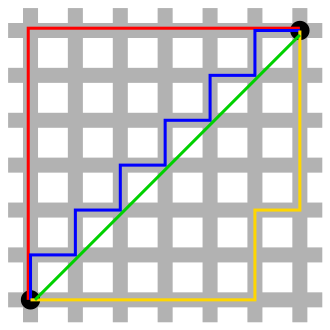Metric space

Metric space is a fundamental concept in the field of mathematics, specifically within the branch of topology. A metric space is defined as a set together with a metric on the set, which is a function that defines a distance between any two elements of the set. The concept of a metric space generalizes the notion of Euclidean distance to more abstract sets, allowing for the rigorous study of the geometry and topology of these sets.
Definition[edit]
A metric space is an ordered pair (M, d) where M is a set and d is a metric on M. The metric d is a function d: M × M → R (where R denotes the set of real numbers) that satisfies the following conditions for any elements x, y, and z in M:
- d(x, y) ≥ 0 (non-negativity)
- d(x, y) = 0 if and only if x = y (identity of indiscernibles)
- d(x, y) = d(y, x) (symmetry)
- d(x, z) ≤ d(x, y) + d(y, z) (triangle inequality)
These properties ensure that the distance between any two points is a non-negative number, the distance is zero if and only if the two points are the same, the distance is the same in both directions, and the direct distance between two points is always less than or equal to the distance via a third point.
Examples[edit]
1. The set of real numbers R with the distance function d(x, y) = |x - y| is a metric space. This is the standard Euclidean metric. 2. The set of n-dimensional real vectors (R^n) with the Euclidean distance function defined as d(x, y) = sqrt((x_1 - y_1)^2 + ... + (x_n - y_n)^2) is also a metric space. 3. The set of continuous functions on a closed interval [a, b] with the distance function defined by the maximum absolute difference over the interval is another example of a metric space.
Properties[edit]
Metric spaces have several important properties that are studied in topology and related fields:
- Open and closed sets: In a metric space, one can define open balls (the set of points within a certain distance from a center point), which are used to define open and closed sets.
- Convergence and limits: A sequence in a metric space is said to converge to a limit if the distances from the sequence elements to the limit become arbitrarily small.
- Continuity: A function between two metric spaces is continuous if it preserves the convergence of sequences.
- Completeness: A metric space is complete if every Cauchy sequence (a sequence where the distance between successive elements becomes arbitrarily small) converges to a limit within the space.
Applications[edit]
Metric spaces are used in various areas of mathematics and applied sciences. They are fundamental in the study of geometry, analysis, and topology. In computer science, metric spaces are used in algorithms for searching and optimizing, particularly in spaces where the notion of distance is defined but does not necessarily follow the standard Euclidean metric. In physics, metric spaces can model the physical space under certain conditions, and in economics, they can represent distances in commodity spaces.
| This article is a stub. You can help WikiMD by registering to expand it. |
Ad. Transform your life with W8MD's Budget GLP-1 injections from $75


W8MD offers a medical weight loss program to lose weight in Philadelphia. Our physician-supervised medical weight loss provides:
- Weight loss injections in NYC (generic and brand names):
- Zepbound / Mounjaro, Wegovy / Ozempic, Saxenda
- Most insurances accepted or discounted self-pay rates. We will obtain insurance prior authorizations if needed.
- Generic GLP1 weight loss injections from $75 for the starting dose.
- Also offer prescription weight loss medications including Phentermine, Qsymia, Diethylpropion, Contrave etc.
NYC weight loss doctor appointmentsNYC weight loss doctor appointments
Start your NYC weight loss journey today at our NYC medical weight loss and Philadelphia medical weight loss clinics.
- Call 718-946-5500 to lose weight in NYC or for medical weight loss in Philadelphia 215-676-2334.
- Tags:NYC medical weight loss, Philadelphia lose weight Zepbound NYC, Budget GLP1 weight loss injections, Wegovy Philadelphia, Wegovy NYC, Philadelphia medical weight loss, Brookly weight loss and Wegovy NYC
|
WikiMD's Wellness Encyclopedia |
| Let Food Be Thy Medicine Medicine Thy Food - Hippocrates |
Medical Disclaimer: WikiMD is not a substitute for professional medical advice. The information on WikiMD is provided as an information resource only, may be incorrect, outdated or misleading, and is not to be used or relied on for any diagnostic or treatment purposes. Please consult your health care provider before making any healthcare decisions or for guidance about a specific medical condition. WikiMD expressly disclaims responsibility, and shall have no liability, for any damages, loss, injury, or liability whatsoever suffered as a result of your reliance on the information contained in this site. By visiting this site you agree to the foregoing terms and conditions, which may from time to time be changed or supplemented by WikiMD. If you do not agree to the foregoing terms and conditions, you should not enter or use this site. See full disclaimer.
Credits:Most images are courtesy of Wikimedia commons, and templates, categories Wikipedia, licensed under CC BY SA or similar.
Translate this page: - East Asian
中文,
日本,
한국어,
South Asian
हिन्दी,
தமிழ்,
తెలుగు,
Urdu,
ಕನ್ನಡ,
Southeast Asian
Indonesian,
Vietnamese,
Thai,
မြန်မာဘာသာ,
বাংলা
European
español,
Deutsch,
français,
Greek,
português do Brasil,
polski,
română,
русский,
Nederlands,
norsk,
svenska,
suomi,
Italian
Middle Eastern & African
عربى,
Turkish,
Persian,
Hebrew,
Afrikaans,
isiZulu,
Kiswahili,
Other
Bulgarian,
Hungarian,
Czech,
Swedish,
മലയാളം,
मराठी,
ਪੰਜਾਬੀ,
ગુજરાતી,
Portuguese,
Ukrainian